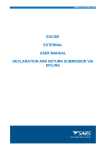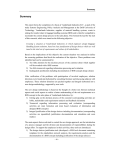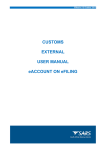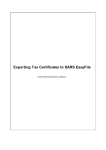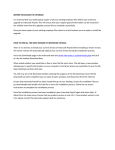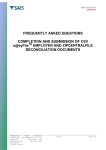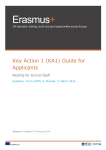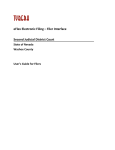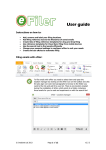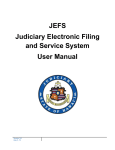Download Excise eAccount on eFiling Guide
Transcript
Excise eAccount on eFiling Guide South African Revenue Service DISCLAIMER The information contained in this guide is intended as guidance only and is not considered to be a legal reference, nor is it a binding ruling. The information does not take the place of legislation and readers who are in doubt regarding any aspect of the information displayed in the guide should refer to the relevant legislation, or seek a formal opinion from a suitably qualified individual. For more information about the contents of this publication you may: • Visit the SARS website at www.sars.gov.za • Visit your nearest SARS branch • Contact your own tax advisor/tax practitioner • If calling from within South Africa, contact the SARS Contact Centre on 0800 00 SARS (7277) • If calling from outside South Africa, contact the SARS Contact Centre on +27 11 602 2093 (only between 8am and 4pm South African time). TABLE OF CONTENTS 1 SCOPE 3 2 eACCOUNT 3 2.1 Introduction 3 2.2 Overview4 3 Excise 5 3.1 Getting started 5 3.1.1 Step 1: Register as an eFiler 5 3.1.2 Step 2: Update your eFiling profile to an ‘Organisation’. 6 3.1.3 Step 3: Activate your Excise client number on eFiling 8 3.1.4 STEP 4: Assign/Create an Admin User 11 3.1.5 STEP 5: Create users for each financial account 13 3.2 Account overview and statements 22 3.2.1 How to view the eAccount Management Dashboard 22 3.2.2 To access the dashboard, follow the steps below: 22 3.2.3 Detailed account balances 24 3.2.4 Excise Statement of Account (ESA) 26 3.3 Payments32 3.3.1 How to pay my account 32 3.3.2 Payment by declaration reference 34 3.3.3 Payment by due date38 3.3.4 Top-up payment options 40 3.4 Account Maintenance 41 3.4.1 Top up selection options 45 Effective 19 October 2013 1 SCOPE This guide will explain account management functionality and show you how to perform the various functions of an eAccount. eAccounts have been created by SARS for you to manage your own financial account. The guide does not cater for Air passenger Tax (APT) clients at this stage. 2 eACCOUNT 2.1 Introduction a) As part of the Customs and Excise modernisation journey, a number of system and process changes have been introduced to facilitate trade in South Africa. At the end of 2012 the first phase of a new Account Management system was introduced to modernise Customs and Excise payment systems and methods. b) Clients have now been given full account management functions online on eFiling. The Excise eAccount will provide users with access to their accounts administered at Customs or Excise offices. Clients will be able to register their Excise client numbers in order to gain access to this management tool. The eFiling eAccount allows full account management functionality per account for the client and reduces the necessity to interact over the counter at the Excise office. c) Clients must be assigned their own unique financial account before being able to use and benefit from the eAccount. d) Excise licensees/registrants will automatically receive their own unique financial account. This financial account is treated as a national account and will be used for all declarations processed at the various Customs or Excise offices. e) The eAccount does not cater for declaration processing but only deals with aspects relating to managing accounts with SARS. 2.2 Overview a) The following functionality is available on eFiling for the client: i) ii) iii) iv) v) Administration A) Register the client’s Excise client number(s) and set up access rights for other users. View my account balance A) This provides clients with an overview of their financial account(s) as processed in the current or previous accounting periods. B) Unallocated payments and credits are also visible. Statement of Account A) Will allow the client to view previously issued progressive Statements of Account as well as to request a Statement of Account from the current month, including all transactions up until the date of request. B) The information displayed on the Statement of Account is summarised and does not reflect detailed information. For more information on the Customs Statement of Account, please refer to the guide on the SARS website. Payments A) Will allow the client to request specific or a grouping of declarations and make payment against these items. Account Maintenance A) The Excise account applies auto-allocation rules to prevent manual account maintenance actions. Manual intervention is, however, required where an incorrect Payment Reference Number (PRN) has been used or an overpayment has been made. B) The Account Maintenance function will allow the client to request specific declarations or a grouping of declarations to be allocated to an available credit. Excise eAccount on eFiling: User Manual External FIN-AM-03 Revision: 1 Page 3 of 41 Effective 19 October 2013 3 Excise 3.1 Getting started a) A number of things need to be in place before a client can access your Excise eAccount. If Excise licensees and registrants have already activated their Excise client number on eFiling, you may continue below from Step 4 onwards. An Excise eAccount needs to be set up per separate Excise client number and a single financial account is created for each client code.. Detailed screen shots and accompanying explanations are included below. i) ii) iii) iv) v) b) STEP 1: Register as an eFiler. Tthe client must be a registered eFiling user to access the Excise eAccount. This will not be necessary if you are already registered on eFiling for Excise filing of accounts or other taxes, such as VAT, PAYE, and/or Income Tax. In that case, you can proceed directly to STEP 2 STEP 2: Update your eFiling Profile to an “Organisation”. This will only be necessary if you are currently registered as an Individual. Changing your profile to “ Organsiation” allows certain added features, including access to the Excise eAccount. If you are already registered as an Organisation, proceed directly to STEP 3. STEP 3: Activate your Excise client number on eFiling (if not already activated for Excise filing of accounts). This allows SARS to activate your Excise profile on SARS eFiling using your Excise client number. STEP 4: Assign/Create an Admin User. This is the person within your organisation that will have overall responsibility to assign users and amend user access rights for the Excise eAccount, what is referred to as the role “Manage Excise Financial Account”. You also have the ability to restrict this, depending on your requirements. This will determine which user can perform STEP 5. If you are already an existing eFiler with an Admin User, you have the ability to also assign this person as the Excise Admin User. Alternatively, you have the ability to assign a completely different person to manage these Excise functions. STEP 5: Create users for the Financial Account. This is the most important step in the process as it allows one to set up user profiles aligned to your organisational structure. An organisation that operates licensed premises across different branch offices will have been assigned a separate financial account for each registered licensee (each separate Excise client number, will have a separate financial account). In this step, one is able to create a single user to manage all accounts (to suit a centralised structure) or create separate users for each account (to suit a decentralised or branch structure). One also has the ability to set up multiple user groups in order to allow different users access to the Excise eAccount functionality: The group access will determine what actions each user linked to the group will be able to A) perform e.g. view only, maintain user groups, make payments and refund requests. B) A listing of all accounts will be available for selection. The group will only have access to the specific selected accounts. The full set-up process for “ Organisations” is not covered in this manual as it is an existing function on eFiling. (General guides are available on the eFiling site.) However, this manual is aimed at providing Excise users with an understanding of the additional functions necessary to effectively use the Excise eAccount. 3.1.1 Step 1: Register as an eFiler a) Go to the SARS eFiling website (www.sarsefiling.co.za). If you are already registered on eFiling, type your Login and Password and click on the Login button. Otherwise, click the Register button and follow the registration steps. This step may already have been performed as part of the registration of the Excise client code for filing purposes. Excise eAccount on eFiling: User Manual External FIN-AM-03 Revision: 1 Page 4 of 41 Effective 19 October 2013 3.1.2 Step 2: Update your eFiling profile to an Organisation. a) In order to allow an Excise client number to be activated, you need to set up eFiling as an “Organisation”. If you are a registered individual on eFiling, go to the Home page on your profile (refer to screenshot below) in order to change your eFiling profile. This step may already have been performed as part of the registration of the Excise client code for filing purposes. b) Select Change Website Profile. Excise eAccount on eFiling: User Manual External FIN-AM-03 Revision: 1 Page 5 of 41 Effective 19 October 2013 c) Select Organisation under the “ New Personality” option, and click on Submit. The new profile will immediately change the background colours and additional options will be available. d) If you need to change your profile back from an Organisation to an Individual, the Change Website Profile tab can be found under the User tab. e) Once you are set up as an Organisation, the top right hand side will indicate that you are now an Organisation. Excise eAccount on eFiling: User Manual External FIN-AM-03 Revision: 1 Page 6 of 41 Effective 19 October 2013 3.1.3 Step 3: Activate your Excise client number on eFiling a) Select the Organisations tab and click Organisation Tax Types in order to register your Excise client number. This step may already have been performed as part of the registration of the Excise client code for filing purposes. b) Tick the Excise Agent tick box for all Excise clients, type in the Excise client number in the Reference Number field, scroll down and click the Register button. c) The system will check if you are an active user. If you are not registered, an error message will be displayed. You must then register on eFiling or contact the SARS Contact Centre on 0800 007277. The status will be updated once the Excise client number is verified and activated. This process may take 24 hours. Excise eAccount on eFiling: User Manual External FIN-AM-03 Revision: 1 Page 7 of 41 Effective 19 October 2013 d) After registration of your Excise client number, you have to add Excise to the Organisation tax types to allow eAccount functionality. Select Manage Groups under Rights Groups and select the required group which will be using the eAccount functionality. Then click on Open to edit the access for the group. e) Select Excise Agent and click on Update, which will give this group access to the Excise eAccount. f) Click on Manage Payers. g) The Add Taxpayers to Group screen will be displayed. Select the relevant Excise client number/s to be linked to the group. Excise eAccount on eFiling: User Manual External FIN-AM-03 Revision: 1 Page 8 of 41 Effective 19 October 2013 h) Click on Manage Users. i) Select the relevant users who require access to the Excise client number and group. Click on the Save button. 3.1.4 STEP 4: Assign/Create an Admin User a) Once the Excise client number has been successfully activated, you need to give a user the required administrator rights. b) An overall administrator (the person who initially registered the Excise client number), will be able to add users and give specific access rights to each user or group of users. This user profile is normally owned by a company’s financial department. Other SARS taxes such as Value-added Tax (VAT) and Pay-As-You-Earn (PAYE) are already administered on eFiling and Excise will be an additional tax type on the organisation’s overall profile. The users who can be set up to access the Excise accounts may include operational staff that are responsible for submission of declarations and/or making payments to SARS Excise for declarations. The main Organisation’s administrator needs to set up users, who will be given access to the Excise accounts, within the current eFiling Organisation’s Add User function. c) If you are an existing eFiler and you would like to extend your current Administrator’s rights to Excise, select the User tab and select Change Details to extend the current administrator’s role to also include the required administrator Excise functionalities. If a new person is to be assigned, select Register New. Excise eAccount on eFiling: User Manual External FIN-AM-03 Revision: 1 Page 9 of 41 Effective 19 October 2013 d) Review details of the administrator. e) Select Update Details to move to the next screen. f) Then select Manage E x c i s e F i n a n c i a l A c c o u n t in order to allow the administrator access to the Excise accounts, and click on Continue. The User Role Manage Excise Financial Account should only be given to the administrator, who will manage the roles relating to the Excise financial account/s. Excise eAccount on eFiling: User Manual External FIN-AM-03 Revision: 1 Page 10 of 41 Effective 19 October 2013 g) Review the user summary and click Continue. 3.1.5 STEP 5: Create users for each financial account a) The client is provided with administrative tools to allow users different levels of access. For example, the eFiling administrator at the client’s head office can give access to each of the trader’s branch managers to use the eAccount functions per licensee account. The users will each receive a specific logon username and first time password, which need to be changed on initial login. Once the user is created, he/she can be linked to an Excise group. b) This process must be achieved in two steps: i) ii) c) Firstly, create all the users by following steps (c) to (g); and Secondly, assign these users (or user) to a group and a financial account, steps (h) to (x). Select Register New and complete the details. Please remember that the user name and first time password needs to be given to the user to gain access to eFiling. The number of users will depend on the business requirements of the eFiler and this process (i.e. (c) to (g)) can be repeated to create a number of users. Excise eAccount on eFiling: User Manual External FIN-AM-03 Revision: 1 Page 11 of 41 Effective 19 October 2013 d) A user may be created with no role. e) To create a user who should NOT have the Manage Excise Financial Account user role, you do not need to select any user role. No user role should therefore be selected for a user who will not be able to edit and adjust the access rights of Excise account groups and users. f) On the other hand, to create auser who should be able to edit and adjust the access rights of Excise account groups and users, select the role of Manage Excise Financial Account. This is only provided to users who should be able to edit and adjust the access rights of Excise account groups and users. Excise eAccount on eFiling: User Manual External FIN-AM-03 Revision: 1 Page 12 of 41 Effective 19 October 2013 g) Review the user summary and click Continue. h) To manage Account Rights, click on Duties and Levies. To set up Groups and link these financial accounts, click Account Rights under the tab Excise Levies & Duties. This will allow the administrator to set up groups, select the accounts linked to a group and link the users. Note that users can only be set up by the administrator of the Organisation’s eFiling profile and needs to be done prior to maintaining groups. i) Click on Account Rights. Excise eAccount on eFiling: User Manual External FIN-AM-03 Revision: 1 Page 13 of 41 Effective 19 October 2013 j) Select Setup New Group and name the group to easily identify the specific use, branches , staff members or access rights. k) Capture the required group name and click on Add. l) Select the group which needs to be set up and click on Open to set up the group’s access rights m) Select the specific access which the group needs to be able to perform a specific function and click on Update to save the access rights. Please ensure that the access rights are aligned to the correct persons/group. Once you have made your selection click on Update. n) If you want to delete a Group Name you need to click on Open. Excise eAccount on eFiling: User Manual External FIN-AM-03 Revision: 1 Page 14 of 41 Effective 19 October 2013 o) Click on Delete Group and the Accounts Rights groups will be updated. p) Click Manage Payers to display all the accounts linked to the Excise client number. This will enable you to view the selection you have made. q) Select the specific financial account which needs to be linked to the group. The Financial Account Selection screen will be displayed, representing the Excise account (there is only one national financial account for each Excise client code). The account number will be a new SARS-generated account number, which is currently the first ten (10) digits of your Payment Reference Number (PRN). r) Click on Save and OK if the selected account is correct. Excise eAccount on eFiling: User Manual External FIN-AM-03 Revision: 1 Page 15 of 41 Effective 19 October 2013 s) The message Group successfully updated will indicate that the changes were saved and then Click on Back. t) Click the Manage Users button to select the users who need to perform the specific actions on the selected accounts. u) Select each user who needs to perform specific tasks relating to the group by clicking the tick box under In Group. Excise eAccount on eFiling: User Manual External FIN-AM-03 Revision: 1 Page 16 of 41 Effective 19 October 2013 v) Click Save and OK if the selection is correct. w) The message Group successfully updated will indicate that the changes or selection was saved. x) The administrator may now inform each of the newly created users of their username and initial password. The individual users may then log on to eFiling using the username and password provided. eFiling will immediately require a new password and the user will thereafter have access according to the group, access rights and accounts to which they were linked. y) The administrator can at any time remove users from groups, edit access rights and add or remove accounts. The client is responsible to maintain all access rights, groups and roles at all times. Excise eAccount on eFiling: User Manual External FIN-AM-03 Revision: 1 Page 17 of 41 Effective 19 October 2013 3.2 Account overview and statements 3.2.1 How to view the eAccount Management Dashboard a) The dashboard is an overview for a specific account which gives you all the information necessary to manage the account effectively. The dashboard also acts as the central point from which all account management functions can be selected. b) The Account Balance Summary highlights the total account balance and any unallocated payments. c) The total balance on account may consist of both unpaid declarations and also unallocated payments. These unallocated payments arise due to an incorrect PRN being specified which prevents the system from automatically allocating the payment. These unallocated payments need to be allocated by you. Payment allocation serves to receipt the payment against declarations, thus marking them off as paid/settled. d) Monthly Statement of Accounts will be made available for each calendar month . The latest issued Statement of Account will be displayed on the dashboard for ease of use. 3.2.2 To access the dashboard, follow the steps below: a) Select Duties and Taxes and choose Account Maintenance. b) The eAccount – Financial Account Selection screen will be displayed. In the event that you have limited access to selected user groups as explained in paragraph 4.1.5 (STEP 5), only those financial accounts linked to the user group will be displayed. Excise eAccount on eFiling: User Manual External FIN-AM-03 Revision: 1 Page 18 of 41 Effective 19 October 2013 c) Select the applicable account number and click View Dashboard/Refresh Account List. The requested account is made available for the specific user to work on, according to access rights granted by the administrator. d) The eAccount Management Dashboard screen for the selected financial account will now be displayed. Please note: The Dashboard screen displays the client details, status-related information and a summary of the account balance. You will also be able to select a Statement of Account, view transactions and make or view payments history. e) If you want to check your most recent account balances, click Refresh Balance under the eFiling Account Balance Summary section. Please note: The Refresh Balances button will allow you to refresh the screen to see the most recent balances from SARS which will be displayed immediately. If real time information is not available, an error message will be displayed. Excise eAccount on eFiling: User Manual External FIN-AM-03 Revision: 1 Page 19 of 41 Effective 19 October 2013 3.2.3 Detailed account balances a) The detailed account balances section provides a summary of transactions per processing date groupings, as well as a total balance. Transactions processed before the current month will display under Previous Periods, while transactions processed in the current month will display under Current Month. The unpaid balances are split between each different declaration and transaction type grouping. This allows complete transparency on the make-up of all unpaid or unallocated transactions on the account. b) You will be able to identify possible overdue declarations and payments requiring allocation at a glance. c) The account balances will highlight the following: i) ii) Unpaid balances which require to be paid by the respective due dates; and Unallocated payments or credits which need to be allocated in order to utilise the payment against declarations. d) On the eAccount Management Dashboard screen, select the View Detailed Balances button from the eFiling Account Balance Summary section. e) This function will allow you to view all detailed balance information from SARS. f) The Excise Account Balance Details screen will be displayed. This function will allow you to view all detailed balance information from SARS. g) You can use this view to see a summary of accounts. Excise eAccount on eFiling: User Manual External FIN-AM-03 Revision: 1 Page 20 of 41 Effective 19 October 2013 h) Select the Back to Dashboard button to go back to the eAccount Management Dashboard screen. 3.2.4 Excise Statement of Account (ESA) a) This will allow you to view statements issued and request specific statements. b) There are two types of statements: i) The historic statement is a monthly Statement of Account issued by SARS at the end of the accounting period. Each financial account will have its own statement. Because this is a request for payment/settlement, this statement includes a PRN specific to the payable statement balance. The user may select the monthly statement and make payment. All unallocated payments have to be allocated for full payment of the Statement of Account to ensure that the full account is settled and all declarations paid. ii) The interim Statement of Account, which includes all transactions subsequent to the last monthly statement, is generated only on request by the client. This statement does not have a PRN and cannot be selected for payment. Payment against transactions included in this statement must be made using the payment process in paragraph 4.3. c) In order to understand the detail contained in the Statement of Account, please refer to the Customs and Excise Statement of Account (CSA/ESA) Guide on the SARS website. d) To view a monthly Statement of Account, select the latest ESA from the Statement of Account section on the eAccount Management Dashboard screen, or select View All to select from previous ESAs. e) The latest Statement of Account issued to you will be displayed on the dashboard. Click on the Statement of Account on the dashboard in order to view the statement. In order to view all previously issued Statements of Account, click on View All. The View All hyperlink will take you to the Excise Statement of Account Home Page, where you will be able to view all ESAs sent to eFiling or request interim ESAs for the current month. Excise eAccount on eFiling: User Manual External FIN-AM-03 Revision: 1 Page 21 of 41 Effective 19 October 2013 f) The Statement of Account request screen will be displayed. Interim Statements of Account can be requested or viewed on this screen and Monthly Statements of Account can be viewed or paid. g) Only monthly Statements issued after registration on eFiling will be available on eFiling. If the Statement of Account requested relates to a period before you were registered for eFiling, the previously issued Statement of Account will only be available from an Excise office. h) Select the Monthly Statement of Account for display. The Statement of Account can be paid by selecting the Make Payment option above ESA. i) The monthly Statement of Account can also be paid by selecting the specific Monthly Statement of Account and clicking on Pay Selected Item. Excise eAccount on eFiling: User Manual External FIN-AM-03 Revision: 1 Page 22 of 41 Effective 19 October 2013 j) Click on Pay Now. Note that the full Statement of Account must be paid and any unallocated payments need to be allocated in order to ensure full settlement. k) Confirm that payment can proceed by clicking on OK. l) The standard eFiling payment process needs to be completed. Please note that the bank account selected has to be set up as a Credit Push account for any Excise payments to be effected and that only final approval on the banking solution constitutes the actual payment. Excise eAccount on eFiling: User Manual External FIN-AM-03 Revision: 1 Page 23 of 41 Effective 19 October 2013 m) Select the I want to request an Interim/Ad-Hoc Statement of Account option and click on the Request button. The Interim Statement of Account will only be available after 24 hours. n) Should you have already requested an Interim Statement of Account and it already displays on your eAccount you will receive a message Review requests made, information was already supplied. For instances where you have already requested an Interim Statement of Account on a specific day and you request it again, you will receive a message Duplicate request and the Interim statement will still be available the next day. Excise eAccount on eFiling: User Manual External FIN-AM-03 Revision: 1 Page 24 of 41 Effective 19 October 2013 o) If you have not already requested an Interim Statement of Account you will receive a message Your request has been scheduled for processing. Your interim Statement of Account should be available against your profile within 24 hours. p) Click on the applicable statement to open it. q) The Interim/Ad-Hoc Statement of Account will be displayed. r) Please note: The ESA will only display transactions up until the date of request. Payment cannot be made on the interim statement. 3.3 Payments 3.3.1 How to pay my account a) There are a number of different options to make payment. Once payment is made, it will result in automated allocation of payments. b) If you have any unallocated payments or credits, this section will also give you access to the ‘Account Maintenance’ option where the allocation of unallocated payments can be made. c) Excise payments can only be made if the selected bank account linked to eFiling is set up for a ‘Credit Push’ payment. This means you need to approve every payment made on eFiling on your bank’s Excise eAccount on eFiling: User Manual External FIN-AM-03 Revision: 1 Page 25 of 41 Effective 19 October 2013 online service. Any payment made via eFiling is only finalised at the point of approval by the bank and allocation to the declarations paid will follow thereafter. d) The selection options for payment and account maintenance are the same in order to identify the declarations and grouping of declarations, but a monthly Statement of Account can only be paid in full and any unallocated payment must be allocated in order for related declarations to be paid. e) The selection options are as follows: i) ii) iii) Individual declarations under ‘I would like to make a payment by’: A) Declaration reference: Request a specific declaration reference (ERN) and only pay or perform account maintenance on this declaration. Only the specific ERN will be displayed if unpaid or a part thereof that is unpaid. B) Due Date: Request a list of declarations by due date. This option will return a list of all declarations and the trader may select specific declarations from the list for payment or to perform account maintenance. As above, only the ERN’s will be displayed if unpaid or a part thereof that is unpaid. Transaction grouping selection options: A) ‘I would like to make a Cash Top up payment’: This option will use the ‘Unpaid Cash Balance’ as an indication of the total value which can be paid or against which account maintenance will be performed. Excise declarations payable are grouped within the Cash Top up balance. B) The allocation of the payment or unallocated payment for this option will be allocated to any unpaid declaration on account and should only be used if you do not specify which declaration needs to be paid. C) If any Top-up grouping option is selected, the amount displayed as the payable value can be edited on the next screen if payment needs to be made. However, in the event of account maintenance, the allocation will be done against the full value. It will be done from the oldest unpaid declaration to the most recent and no editing is available. When making payment, or allocating a credit, please note the following rules: A) Each PRN is linked to a specific declaration or grouping of declarations. The first ten (10) digits of the PRN represent your financial account number. B) Any excess payment that remains after clearing all declarations that relate to the PRN will remain on the account as an unallocated credit. C) Where there is an underpayment, the payment will first allocate to all cash declarations that are linked to the PRN. The payment will allocate to the oldest unpaid declaration first. Remaining declarations will remain on the account as unpaid. D) If a ‘Top-up’ payment is selected, payment will be allocated to the oldest transaction in the group. E) When paying a ‘Top-up’, the client may edit the payment value.. f) The standard eFiling payment process is used after selecting the transaction or grouping for payment; therefore multiple declarations can be selected as single payments. These payments are all saved to the list of items which will be paid and a final single payment instruction for all items can be made. The final payment is only effected after approval on the bank’s online solution. g) All recent payments and their applicable status will reflect on the dashboard. h) Click on the Make a Payment button on the eAccount Management Dashboard screen under ‘Recent Payments’. Excise eAccount on eFiling: User Manual External FIN-AM-03 Revision: 1 Page 26 of 41 Effective 19 October 2013 i) You can also make payment on the monthly Statement of Account, by clicking on the Pay Selected Item button on the respective functionality screens. j) The Excise Payment Options screen is now displayed. k) You have the option to choose different types of payments and then select the Proceed to Account Maintenance or Proceed to Make Payment or Back to Dashboard button at the bottom of the page. 3.3.2 Payment by declaration reference a) If you make a payment for a single ERN by declaration reference, type in the ERN number and select Proceed to make Payment. Excise eAccount on eFiling: User Manual External FIN-AM-03 Revision: 1 Page 27 of 41 Effective 19 October 2013 b) If a payment is made by declaration reference, the ERN number can be obtained from the declaration. c) Select an amount and click on the Pay Now button. d) You cannot edit the value for declarations and the full declaration will be paid (See Payment by Due date below if the declaration has different due dates, and only a part of the declaration which is due must be paid). You can save payments by clicking on the Save Payment button, if payment will only be done later. A message will be displayed to show that the payment has been saved. e) Click on the OK button to proceed with payment. Excise eAccount on eFiling: User Manual External FIN-AM-03 Revision: 1 Page 28 of 41 Effective 19 October 2013 f) The Payment Details screen will be displayed and the standard eFiling payment process can then be followed. g) The bank details should be set up when registering on eFiling. Remember that only credit push payments will be allowed for payment of Excise declarations and a reminder message is displayed in red. h) In the Payment Details section, select the bank account that was set up as a credit push payment type. i) Click on the Pay Now button. Excise eAccount on eFiling: User Manual External FIN-AM-03 Revision: 1 Page 29 of 41 Effective 19 October 2013 j) Confirm payment initiation by clicking on the Confirm button. k) Click on the OK button. l) Payment transactions that are initiated on the eFiling site are sent electronically to the bank as a payment request. Only after the user has logged into the banking product and authorised the payment request, is the payment actually made to SARS. Credit Push transactions are assumed to be irrevocable. Excise eAccount on eFiling: User Manual External FIN-AM-03 Revision: 1 Page 30 of 41 Effective 19 October 2013 m) On the Payment Initiation Results screen, click on the Continue button. n) To view, click on eAccount Payments. o) On the eAccount Management Dashboard screen under the Recent Payments section, the payments made will be displayed. 3.3.3 Payment by due date a) If you want to make a payment by a due date, select and enter the Due Date and click on Proceed to Make Payment. This option will be used where a single declaration has multiple payment due dates and a payment must be made per due date. Excise eAccount on eFiling: User Manual External FIN-AM-03 Revision: 1 Page 31 of 41 Effective 19 October 2013 b) The Payment Summary screen will be displayed with all unpaid declarations due on the requested date. c) To view the details of a specific declaration, click on the Doc No. d) The Excise Transaction Listing Detail screen displays the details of any declaration selected. e) Select the specific declarations for payment and click on the Pay Now button. Excise eAccount on eFiling: User Manual External FIN-AM-03 Revision: 1 Page 32 of 41 Effective 19 October 2013 f) Click on the OK button to proceed with payment. g) The standard eFiling payment process can then be followed. 3.3.4 Top-up payment options a) If you would like to make a top-up payment in order to make a payment towards the oldest unpaid declaration, you should make a Cash top up payment, select the I would like to make a Cash top up payment option and select the Proceed to make Payment button. b) The amount is pre-populated with the total unpaid balance for the specific selection. This total value is only to help you to understand the maximum value that can be paid. If no amount is unpaid, no top-up payment can be performed for the selection. Excise eAccount on eFiling: User Manual External FIN-AM-03 Revision: 1 Page 33 of 41 Effective 19 October 2013 c) The Payment Summary screen will now be displayed. d) The total amount that will actually be paid can be changed to the value that you want to pay towards the top-up option. You can then continue to the next screen or click on the Pay Now button. e) Change the amount if applicable and click on the Pay Now button. f) The standard eFiling payment process will then be followed as explained above. 3.4 Account Maintenance a) Clients will use this functionality to resolve unallocated payments or credits that are highlighted in the ‘Balance Summary’ section of the dashboard. b) As part of the payment function from the dashboard, the client can allocate unallocated payments and credits to specific declarations or against the Cash top-up option. c) The selection options to identify declarations or the Cash top-up option are the same as for when payments are made. Please refer to the explanation of the options under the ‘Payments’ section. d) The client cannot undo allocations and therefore needs to make sure that selections and allocations are done accurately. Similarly, the selected unallocated payment has to be carefully selected in order to ensure that the payment date precedes the due date of the declarations selected to reduce any possible penalties or interest. e) The ‘Account Maintenance’ screen will display the requested declaration/s or top-up option under the ‘Uncleared Bills’ section and the available unallocated payments and credits will display under the ‘Unallocated Payments’ section. f) An allocation can only be performed by selecting a single unallocated payment at a time, but multiple unpaid declarations may be selected under the Uncleared Bills. If the trader decides that no allocation should be made and the Uncleared Bills should rather be paid, select NONE SELECTED under ‘Unallocated Payments’ and the ‘Make Payment’ option will appear. g) On selection, the items will move to the Assigned section. Thereafter, an allocation or payment can be made. Excise eAccount on eFiling: User Manual External FIN-AM-03 Revision: 1 Page 34 of 41 Effective 19 October 2013 h) Select the Make a Payment button in order to gain access to the Account Maintenance option. i) If you want to allocate a payment to specific declarations, capture the ERN or the Due date and click on the Proceed to Account Maintenance button. (Only the selection for an ERN is explained here as selection by Due date will be similar.) j) The requested ERN’s will display under Uncleared Bills and one (1) or more declarations can be selected. In order to identify the declarations due date and details, click on the Doc No. of the declaration. Excise eAccount on eFiling: User Manual External FIN-AM-03 Revision: 1 Page 35 of 41 Effective 19 October 2013 k) The details of the selected declaration and due date will assist the user to select the correct declarations and the specific unallocated payment, which should be allocated against the declaration l) Once the correct declaration(s) and unallocated payment are selected, click on Assign selected values. Excise eAccount on eFiling: User Manual External FIN-AM-03 Revision: 1 Page 36 of 41 Effective 19 October 2013 m) The selection will then be displayed in the Assigned section. This is the final review section and therefore care must be taken that the allocation is correct. If the allocation is correct, click on Submit Allocation. n) A success message will display on completion and the account balances will be updated with the allocation. Excise eAccount on eFiling: User Manual External FIN-AM-03 Revision: 1 Page 37 of 41 Effective 19 October 2013 3.4.1 Cash Top up selection option a) The Cash top-up option with a positive balance will be available for selection to perform an allocation of unallocated payments towards the payable balance. b) Go to the Account Maintenance screen and select the Cash Top-up option. c) You can view the top-up option selected in the Uncleared bills section, while unallocated payments display under the Unallocated Payments section. The top-up option and the relevant unallocated payment need to be selected in order to assign the selection. d) Select the relevant Uncleared Bill and Unallocated Payment and click on the Assign selected values button. Excise eAccount on eFiling: User Manual External FIN-AM-03 Revision: 1 Page 38 of 41 Effective 19 October 2013 e) You have the option to select multiple declarations, but top-up options will only display the selected top-up option. The selected uncleared bills can be allocated against a single unallocated payment. f) Once the Assigned Bills and the Assigned Payments are displayed, click on the Submit Allocation button. g) You can remove the Assigned Bills and Payments by clicking on the Remove Selected Items button. h) View the message that is displayed on the Allocation Confirmation screen and click on the Continue button. Excise eAccount on eFiling: User Manual External FIN-AM-03 Revision: 1 Page 39 of 41 Effective 19 October 2013 i) After an open credit or allocation was successfully performed, the result will be processed immediately. Excise eAccount on eFiling: User Manual External FIN-AM-03 Revision: 1 Page 40 of 41 Effective 19 October 2013 Please Note: The Account Balance Summary can be refreshed to display the effect of the allocations which were performed. Disclaimer: This document is not meant to delve into the precise technical and legal detail that is associated with Excise. It should, therefore, not be used as a legal reference. Should you require additional information regarding Customs payments, visit a Excise branch, call the SARS Contact Centre on 0800 00 SARS (7277), visit SARS online at www.sars.gov.za and/or contact your own advisors. Excise eAccount on eFiling: User Manual External FIN-AM-03 Revision: 1 Page 41 of 41










































